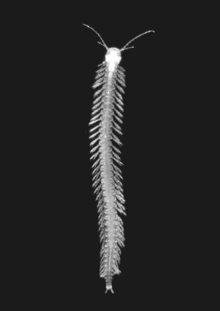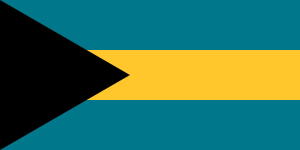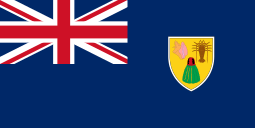Remipedia
Remipedia is a class of blind crustaceans found in coastal aquifers which contain saline groundwater, with populations identified in almost every ocean basin so far explored, including in Australia, the Caribbean Sea, and the Atlantic Ocean. The first described remipede was the fossil Tesnusocaris goldichi (Lower Pennsylvanian). Since 1979, at least seventeen living species have been identified in subtropical regions around the world.[1]
| Remipedes | |
|---|---|
 | |
| Speleonectes tanumekes | |
| Scientific classification | |
| Kingdom: | Animalia |
| Phylum: | Arthropoda |
| Subphylum: | Crustacea |
| Class: | Remipedia J. Yager 1981 |
| Orders & families | |
| |
Description
Remipedes are 1–4 centimetres (0.4–1.6 in) long and comprise a head and an elongate trunk of up to thirty-two similar body segments.[2] They lack eyes and pigmentation.[3] Biramous swimming appendages are laterally present on each segment, and the animals swim on their backs. They are generally slow-moving.[4] They are the only known venomous crustaceans, and have fangs connected to secretory glands, which inject a combination of digestive enzymes and venom into their prey.[5]
Remipedia have a generally primitive body plan compared to other extant crustaceans, and are the only extant pancrustaceans to lack significant postcephalic tagmosis.[4] Previously regarded as 'primitive', remipedia have since been shown to have enhanced olfactory nerve centers (a common feature for species that live in dark environments).[6]
History of classification
The class Remipedia was erected in 1981 by Jill Yager, in describing Speleonectes lucayensis from the Bahamas.[7] The name "Remipedia" is from the Latin remipedes, meaning "oar-footed".[7]
Historical phylogeny based on morphology and physiology has placed Remipedia under Mandibulata, in the subphylum Crustacea, and distinct from Hexapoda.
New research in evolution and development reveals similarities between larvae and postembryonic development of remipedes and Malacostraca, singling Remipedia as a potential crustacean sister group of Hexapoda. Similarities in brain anatomy further support this affinity, and hexapod-type hemocyanins have been discovered in remipedes.[8]
Recent analysis based on nuclear protein-coding genes implies that remipedes (along with Cephalocarida) are the sister group of arthropods most closely related to insects. Remipedia and Cephalocarida are grouped together form the clade Xenocarida.[9] The extant lineages Xenocarida, Vericrustacia, Oligostraca, and Hexapoda together form the proposed class Pancrustacea. The clade Miracrustacea ('surprising crustaceans') has been proposed for the monophyletic clade containing xenocarids and hexapods.[4]
Classification
| ||||||||||||||||||||||||||||||||||||||||||||||||||||||||||||
| Phylogenetic position of Remipedia within Pancrustacea[10] |
Twenty eight extant species are recognized as of early 2016, divided among eight families and twelve genera.[11] All are placed in the order Nectiopoda. The second order, Enantiopoda, comprises the fossil species Tesnusocaris goldichi and Cryptocaris hootchi.[1]
- †Order Enantiopoda Birshtein 1960
- †Family Tesnusocarididae Brooks 1955 [Cryptocarididae Sieg 1980]
- Genus †Tesnusocaris Brooks 1955
- †Tesnusocaris goldichi Brooks 1955
- Genus †Cryptocaris Emerson & Schram 1985
- †Cryptocaris hootchi Emerson & Schram 1985
- Genus †Tesnusocaris Brooks 1955
- †Family Tesnusocarididae Brooks 1955 [Cryptocarididae Sieg 1980]
- Order Nectiopoda Schram 1986
- Family Micropacteridae Koenemann, Iliffe & van der Ham 2007
- Genus Micropacter Koenemann, Iliffe & van der Ham 2007
- Micropacter yagerae Koenemann, Iliffe & van der Ham 2007
- Genus Micropacter Koenemann, Iliffe & van der Ham 2007
- Family Godzilliidae Schram, Yager & Emerson 1986
- Genus Godzilliognomus Yager 1989
- Godzilliognomus frondosus Yager, 1989
- Godzillognomus schrami Iliffe, Otten & Koenemann 2010
- Genus Godzillius Schram et al., 1986
- Godzillius fuchsi Gonzalez, Singpiel & Schlagner 2013
- Godzillius robustus Schram, Yager & Emerson 1986
- Genus Godzilliognomus Yager 1989
- Family Kumongidae Hoenemann et al. 2013
- Genus Kumonga Hoenemann et al. 2013
- Kumonga exleyi (Yager & Humphreys 1996) Hoenemann et al. 2013 [Lasionectes exleyi Yager & Humphreys 1996]
- Genus Kumonga Hoenemann et al. 2013
- Family Cryptocorynetidae Hoenemann et al. 2013
- Genus Kaloketos Koenemann, Iliffe & Yager 2004
- Kaloketos pilosus Koenemann, Iliffe & Yager 2004
- Genus Angirasu Hoenemann et al. 2013
- Angirasu benjamini (Yager 1987) Hoenemann et al. 2013 [Speleonectes benjamini Yager 1987]
- Angirasu parabenjamini (Koenemann, Iliffe & van der Ham 2003) Hoenemann et al. 2013 [Speleonectes parabenjamini Koenemann, Iliffe & van der Ham 2003]
- Genus Cryptocorynetes Yager 1987
- Cryptocorynetes elmorei Hazerli, Koenemann & Iliffe 2009 [12]
- Cryptocorynetes haptodiscus Yager 1987
- Cryptocorynetes longulus Wollermann, Koenemann & Iliffe 2007
- Genus Kaloketos Koenemann, Iliffe & Yager 2004
- Family Morlockiidae García-Valdecasas 1984
- Genus Morlockia García-Valdecasas 1984
- Morlockia williamsi (Hartke, Koenemann & Yager 2011) [Speleonectes williamsi Hartke, Koenemann & Yager 2011][13]
- Morlockia emersoni (Lorentzen, Koenemann & Iliffe 2007) [Speleonectes emersoni Lorentzen, Koenemann & Iliffe 2007]
- Morlockia atlantida (Koenemann et al. 2009) Hoenemann et al. 2012 [Speleonectes atlantidus Koenemann et al. 2009]
- Morlockia ondinae García-Valdecasas 1984 [Speleonectes ondinae (Garcia-Valdecasas 1984)]
- Genus Morlockia García-Valdecasas 1984
- Family Speleonectidae Yager 1981
- Genus Lasionectes Yager & Schram, 1986
- Lasionectes entrichoma Yager & Schram, 1986
- Genus Speleonectes Yager 1981
- Speleonectes cokei Yager, 2013[14]
- Speleonectes epilimnius Yager & Carpenter, 1999
- Speleonectes gironensis Yager, 1994
- Speleonectes kakukii Daenekas et al., 2009
- Speleonectes lucayensis Yager, 1981
- Speleonectes minnsi Koenemann, Iliffe & van der Ham, 2003
- Speleonectes tanumekes Koenemann, Iliffe & van der Ham, 2003
- Genus Lasionectes Yager & Schram, 1986
- Family Xibalbanidae Olesen et al. 2017
- Genus Xibalbanus Hoenemann et al. 2013
- Xibalbanus fuchscockburni (Neiber et al. 2012) Hoenemann et al. 2013 [Speleonectes fuchscockburni Neiber et al. 2012][15]
- Xibalbanus tulumensis (Yager 1987) Hoenemann et al. 2013 [Speleonectes tulumensis Yager 1987]
- Genus Xibalbanus Hoenemann et al. 2013
- Family Pleomothridae Hoenemann et al. 2013
- Genus Pleomothra Yager 1989
- Pleomothra apletocheles Yager 1989
- Pleomothra fragilis Koenemann, Ziegler & Iliffe 2008
- Genus Pleomothra Yager 1989
- Family Micropacteridae Koenemann, Iliffe & van der Ham 2007
Geographic distribution of extant Remipedia


.svg.png)




References
- Stefan Koenemann; Frederick R. Schram; Mario Hönemann & Thomas M. Iliffe (2007). "Phylogenetic analysis of Remipedia (Crustacea)". Organisms Diversity & Evolution. 7 (1): 33–51. doi:10.1016/j.ode.2006.07.001.
- Cameron McCormick (November 10, 2008). "Remipedia". The Lord Geekington.
- Yager, J. (18 September 2013). "Lasionectes entrichoma Yager & Schram, 1986". tamug.edu. Retrieved 9 February 2018.
- Regier, Jerome C.; Shultz, Jeffrey W.; Zwick, Andreas; Hussey, April; Ball, Bernard; Wetzer, Regina; Martin, Joel W.; Cunningham, Clifford W. (February 2010). "Arthropod relationships revealed by phylogenomic analysis of nuclear protein-coding sequences". Nature. 463 (7284): 1079–1083. Bibcode:2010Natur.463.1079R. doi:10.1038/nature08742. ISSN 0028-0836. PMID 20147900.
- Kaplan, Matt (22 October 2013). "First venomous crustacean discovered". Nature News. doi:10.1038/nature.2013.13985. Retrieved 10 May 2015.
- Martin Fanenbruck; Steffen Harzsch & Johann Wolfgang Wägele (2004). "The brain of the Remipedia (Crustacea) and an alternative hypothesis on their phylogenetic relationships". Proceedings of the National Academy of Sciences. 101 (11): 3868–3873. doi:10.1073/pnas.0306212101. PMC 374336. PMID 15004272.
- Jill Yager (August 1981). "Remipedia, a new class of Crustacea from a marine cave in the Bahamas". Journal of Crustacean Biology. 1 (3): 328–333. doi:10.2307/1547965. JSTOR 1547965.
- Giribet, Gonzalo; Edgecombe, Gregory D. (2012-01-07). "Reevaluating the Arthropod Tree of Life". Annual Review of Entomology. 57 (1): 167–186. doi:10.1146/annurev-ento-120710-100659. ISSN 0066-4170. PMID 21910637.
- Bjoern M. von Reumont; Ronald A. Jenner; Matthew A. Wills; Emiliano Dell'Ampio; Günther Pass; Ingo Ebersberger; Benjamin Meyer; Stefan Koenemann; Thomas M. Iliffe; Alexandros Stamatakis; Oliver Niehuis; Karen Meusemann & Bernhard Misof (March 2012). "Pancrustacean phylogeny in the light of new phylogenomic data: support for Remipedia as the possible sister group of Hexapoda". Molecular Biology and Evolution. 29 (3): 1031–1045. doi:10.1093/molbev/msr270. PMID 22049065.
- Lozano-Fernandez, Jesus; Giacomelli, Mattia; Fleming, James F; Chen, Albert; Vinther, Jakob; Thomsen, Philip Francis; Glenner, Henrik; Palero, Ferran; Legg, David A; Iliffe, Thomas M; Pisani, Davide; Olesen, Jørgen (2019). "Pancrustacean Evolution Illuminated by Taxon-Rich Genomic-Scale Data Sets with an Expanded Remipede Sampling". Genome Biology and Evolution. 11 (8): 2055–2070. doi:10.1093/gbe/evz097. ISSN 1759-6653. PMC 6684935. PMID 31270537.
- Stefan Koenemann. "World Remipedia Database". Vlaams Instituut voor de Zee. Retrieved 7 December 2017.
- Dennis Hazerli; Stefan Koenemann & Thomas M. Iliffe (2010). "Cryptocorynetes elmorei, a new species of Remipedia (Crustacea) from an anchialine cave on Eleuthera, Bahamas". Marine Biodiversity. 40 (2): 71–78. doi:10.1007/s12526-009-0033-4.
- Tamara R. Hartke; Stefan Koenemann & Jill Yager (2011). "Speleonectes williamsi, a new species of Remipedia (Crustacea) from the Bahamas" (PDF excerpt). Zootaxa. 3115: 21–28. doi:10.11646/zootaxa.3115.1.2.
- Yager J (2013). "Speleonectes cokei, new species of Remipedia (Crustacea: Speleonectidae) from a submerged ocean cave near Caye Chapel, Belize". Zootaxa. 3710 (4): 354–362. doi:10.11646/zootaxa.3710.4.4. PMID 26106696.
- Marco T. Neiber; Finja C. Hansen; Thomas M. Iliffe; Brett C. Gonzalez & Stefan Koenemann (2012). "Molecular taxonomy of Speleonectes fuchscockburni, a new pseudocryptic species of Remipedia (Crustacea) from an anchialine cave system on the Yucatán Peninsula, Quintana Roo, Mexico" (PDF excerpt). Zootaxa. 3190: 31–46. doi:10.11646/zootaxa.3190.1.2.
- Lorentzen, Dörte; Koenemann, Stefan; Iliffe, Thomas M. (2007). "Speleonectes Emersoni, A New Species of Remipedia (Crustacea) from the Dominican Republic". doi:10.5281/zenodo.177940. Cite journal requires
|journal=(help)
External links
